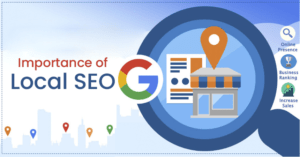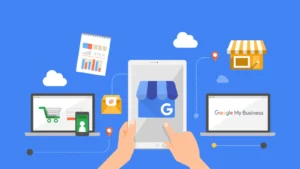What is local SEO?

Local SEO is a powerful digital marketing strategy designed to enhance a business’s visibility in location-based search results. For small businesses, it plays a crucial role in connecting with nearby customers actively seeking products or services.
Key Features of Local SEO:
- Google My Business (GMB): A fully optimized GMB profile ensures visibility on Google Maps and in local search results.
- Local Citations: Accurate Name, Address, and Phone Number (NAP) details across directories boost credibility.
- Geo-Specific Keywords: Using terms like “plumber in Boston” helps businesses rank higher in localized searches.
Examples:
- A coffee shop in Amsterdam can optimize for “best coffee near me” or “Amsterdam coffee shop.”
- A Los Angeles-based florist could use keywords like “flower delivery LA” to attract nearby customers.
Benefits of Local SEO:
- Drives more organic traffic from location-based searches.
- Enhances online visibility and increases foot traffic.
- Builds customer trust through reviews and direct engagement.
Why Local SEO Matters for Small Businesses
Small businesses often face stiff competition from larger enterprises with robust marketing budgets. Local SEO levels the playing field, enabling them to compete effectively.
- Growing Consumer Trends:
- “Near me” searches have surged by 150% in recent years, reflecting a growing reliance on mobile searches for immediate solutions.
- Approximately 46% of Google searches are local, underscoring the importance of location-based visibility.
- Reaching Mobile Users:
- Mobile users frequently conduct searches like “restaurants open now near me.”
- Local SEO ensures mobile-friendly results, such as appearing in Google Maps or local packs.
- Building Trust:
- Positive reviews and a strong GMB presence enhance trustworthiness.
- Consumers tend to prefer local businesses for their proximity, accessibility, and personalized services.
Example:
A bakery in Boston saw a 30% rise in online orders by targeting “fresh bread near me” and actively managing its GMB profile.
Key Elements of a Local SEO Strategy
A successful local SEO strategy requires attention to specific elements that directly impact visibility and engagement.
-
Google My Business (GMB):

- Complete Your Profile: Ensure your GMB profile includes accurate NAP information, hours of operation, and relevant categories.
- Post updates regularly: Share news, promotions, and events to keep your listing active.
- Use Photos and Videos: Businesses with images see 42% more requests for directions and 35% more website clicks.
-
Local Keywords:
- Keyword Research: Identify location-specific terms like “cheap haircut in Chicago.”
- Integration: Use these keywords in titles, meta descriptions, and page content.
-
Customer Reviews:
- Encourage customers to leave reviews on Google, Yelp, and industry-specific platforms.
- Respond to reviews—both positive and negative—to show your commitment to customer satisfaction.
-
Local Backlinks:
- Build relationships with local bloggers, directories, and community websites.
- Examples include links from the local Chamber of Commerce or neighborhood newspapers.
-
Citation Management:
- Maintain consistent NAP information across all platforms.
- Use tools like Bright Local to manage citations effectively.
-
Schema Markup:
- Implement location schema markup to help search engines better understand your business’s location and services.
How to Optimize Google My Business
Optimizing your GMB profile is the cornerstone of any local SEO strategy.
Steps for Effective GMB Optimization:
- Ensure NAP accuracy: Verify that your name, address, and phone number are consistent across platforms.
- Add Quality Images: High-quality photos of your storefront, team, and products enhance engagement.
- Post Regularly: Use GMB posts to share updates, blog links, offers, and events.
- Engage with Reviews:
- Respond to positive reviews to build loyalty.
- Address negative reviews promptly and professionally to resolve issues.
- Monitor GMB Insights: Use GMB’s analytics to track customer actions, such as clicks and calls, and refine your approach.
Pro Tip: Listings with frequent updates and photos receive up to 50% more engagement.
Local SEO vs. Traditional SEO
Understanding the difference between local and traditional SEO helps businesses prioritize their strategies effectively.
| Aspect | Local SEO | Traditional SEO |
| Audience | Local customers seeking immediate solutions | Global or national audiences |
| Key Tools | GMB, citations, local keywords | Domain authority, content quality |
| Ranking Factors | Proximity, reviews, citation accuracy | Backlinks, content relevance |
| SERP Features | Local Pack, Google Maps | Featured snippets, organic results |
Key Insight: Local SEO drives direct action (e.g., foot traffic or inquiries), while traditional SEO focuses on long-term visibility.
Common Challenges
While local SEO delivers excellent results, small businesses often encounter challenges.
- Duplicate Listings:
Unverified or duplicate GMB listings can confuse customers and impact rankings. Use tools like Moz Local to identify and clean up duplicates. - Spam Reviews:
Fake reviews from competitors or bots can harm reputations. Report these to Google using their review reporting tools. - Limited Budget:
Investing in advanced tools or professional services may strain a small business’s budget. Free tools like GMB and affordable options like Bright Local are effective alternatives. - Citation Inconsistency:
Discrepancies in NAP details across platforms confuse search engines. Tools like Yext streamline citation monitoring and correction.
Local SEO Tools Every Small Business Should Use
Using the right tools can enhance efficiency and deliver measurable results.
Top Local SEO Tools:
- BrightLocal: Manages citations, monitors reviews, and tracks local rankings.
- Moz Local: Ensures NAP consistency across directories.
- Ahrefs provides keyword research and backlink analysis.
- Google Analytics & Search Console: Tracks website and local SEO performance.
Case Study:
A boutique clothing store increased foot traffic by 50% after using BrightLocal for citation management and Moz Local for keyword tracking.
Advanced Local SEO Tactics: Hyperlocal Targeting

For even greater success, businesses can employ advanced local SEO techniques.
-
Hyperlocal Content:
- Create content for specific neighborhoods or zip codes.
- Example: A pizzeria targeting “Brooklyn Heights pizza delivery.”
-
Voice Search Optimization:
- Adapt to conversational search queries like “Where’s the nearest bike repair shop?”
- Focus on long-tail keywords and natural phrasing.
-
AI-Driven Personalization:
- Use AI tools to segment audiences based on location and behavior.
- Example: A cleaning service targeting specific zip codes saw a 40% rise in inquiries.
-
Mobile Optimization:
- Ensure websites are responsive and mobile-friendly.
- 61% of mobile users are likely to contact a local business if their site is easy to navigate.
The ROI of Local SEO for Small Businesses

Local SEO is one of the most cost-effective marketing strategies, offering significant returns for small businesses.
Why Local SEO Delivers High ROI:
-
Affordable Visibility:
- Tools like GMB and Bright Local provide affordable solutions for visibility.
-
Customer Retention:
- Engaged customers trust local businesses and are more likely to return.
-
Sustained Growth:
- Efforts compound over time, ensuring long-term benefits.
Example:
A local landscaping company increased its client base by 60% within a year by investing in local SEO and managing customer reviews.
FAQs
Q1: How long does it take to see results from local SEO?
Local SEO efforts typically yield results within 3–6 months, depending on competition and consistency.
Q2: Can service-based businesses without physical locations benefit from local SEO?
Yes, such businesses can specify their service areas on GMB to target local customers.
Q3: What is the local pack?
The local pack displays the top three businesses relevant to a user’s search query on Google Maps and search results.
Q4: How important are reviews for local SEO?
Reviews are crucial. Businesses with more positive reviews tend to rank higher and build trust.
Q5: Can local SEO complement traditional SEO?
Yes, combining both ensures maximum reach—local for immediate needs and traditional for broader visibility.
By mastering local SEO, small businesses can attract more customers, establish trust, and compete effectively in their markets. With consistent effort and the right tools, local SEO offers both immediate and long-term benefits that can transform your business.
